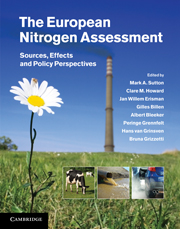Book contents
- Frontmatter
- Contents
- List of contributors
- Foreword
- Summary for policy makers
- Technical summary
- 1 Assessing our nitrogen inheritance
- Part I Nitrogen in Europe: the present position
- Part II Nitrogen processing in the biosphere
- Part III Nitrogen flows and fate at multiple spatial scales
- Part IV Managing nitrogen in relation to key societal threats
- Part V European nitrogen policies and future challenges
- 22 Costs and benefits of nitrogen in the environment
- 23 Developing integrated approaches to nitrogen management
- 24 Future scenarios of nitrogen in Europe
- 25 Coordinating European nitrogen policies between international conventions and intergovernmental organizations
- 26 Societal choice and communicating the European nitrogen challenge
- Glossary
- Index
- References
24 - Future scenarios of nitrogen in Europe
from Part V - European nitrogen policies and future challenges
Published online by Cambridge University Press: 16 May 2011
- Frontmatter
- Contents
- List of contributors
- Foreword
- Summary for policy makers
- Technical summary
- 1 Assessing our nitrogen inheritance
- Part I Nitrogen in Europe: the present position
- Part II Nitrogen processing in the biosphere
- Part III Nitrogen flows and fate at multiple spatial scales
- Part IV Managing nitrogen in relation to key societal threats
- Part V European nitrogen policies and future challenges
- 22 Costs and benefits of nitrogen in the environment
- 23 Developing integrated approaches to nitrogen management
- 24 Future scenarios of nitrogen in Europe
- 25 Coordinating European nitrogen policies between international conventions and intergovernmental organizations
- 26 Societal choice and communicating the European nitrogen challenge
- Glossary
- Index
- References
Summary
Executive summary
Nature of the problem
The future effects of nitrogen in the environment will depend on the extent of nitrogen use and the practical application techniques of nitrogen in a similar way as in the past. Projections and scenarios are appropriate tools for extrapolating current knowledge into the future. However, these tools will not allow future system turnovers to be predicted.
Approaches
In principle, scenarios of nitrogen use follow the approaches currently used for air pollution, climate, or ecosystem projections. Short-term projections (to 2030) are developed using a ‘baseline’ path of development, which considers abatement options that are consistent with European policy. For medium-term projections (to 2050) and long-term projections, the European Nitrogen Assessment (ENA) applies a ‘storyline’ approach similar to that used in the IPCC SRES scenarios. Beyond 2050 in particular, such storylines also take into account technological and behavioral shifts.
Key findings/state of knowledge
The ENA distinguishes between driver-oriented and effect-oriented factors determining nitrogen use. Parameters that cause changes in nitrogen fixation or application are called drivers. In a driver-based approach, it is assumed that any variation of these parameters will also trigger a change in nitrogen pollution. In an effect-based approach, as the adverse effects of nitrogen become evident in the environment, introduction of nitrogen abatement legislation requiring the application of more efficient abatement measures is expected. This approach needs to rely on a target that is likely to be maintained in the future (e.g. human health). Nitrogen abatement legislation based on such targets will aim to counter any growth in adverse environmental effects that occur as a result of increased nitrogen application.
[…]
- Type
- Chapter
- Information
- The European Nitrogen AssessmentSources, Effects and Policy Perspectives, pp. 551 - 569Publisher: Cambridge University PressPrint publication year: 2011
References
- 7
- Cited by



